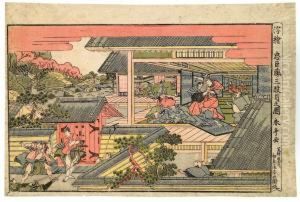Katsukawa Shuntei Paintings
Katsukawa Shuntei was a Japanese ukiyo-e artist who lived during the Edo period. Born in 1770, he was part of the Katsukawa school, which was renowned for its depictions of kabuki actors, sumo wrestlers, and beautiful women (bijin-ga). Shuntei, like many artists of his time, adopted a 'gō' (artist name) that linked him to the school's founder, Katsukawa Shunshō. This practice was common among ukiyo-e artists, who often passed down their names to students or successors as a way to honor the lineage and maintain the stylistic and thematic continuity of the school.
Shuntei's work is characterized by its vibrant colors, dynamic compositions, and detailed portrayal of contemporary Edo life. He specialized in yakusha-e (actor prints), illustrating the popular kabuki actors of his time in their most famous roles. These prints served not only as entertainment but also as a way for the populace to keep up with the ever-changing world of kabuki theater. Additionally, Shuntei produced sumo-e (sumo wrestling prints) and bijin-ga, contributing to the wide array of subjects covered by the Katsukawa school.
Despite the popularity of his works during his lifetime, Shuntei did not achieve the same lasting fame as some of his contemporaries, such as Katsushika Hokusai or Utagawa Hiroshige. However, his contributions to the ukiyo-e genre, particularly in the realm of actor prints, remain important for the study of Edo period art and culture. Through his detailed and expressive prints, Shuntei captured the vibrancy of Edo's urban landscape and its inhabitants, offering modern viewers a glimpse into the pastimes and passions of 18th and early 19th-century Japan.
Shuntei's legacy is preserved in collections around the world, where his prints continue to be studied and appreciated for their artistic quality and cultural significance. He died in 1820, leaving behind a body of work that continues to contribute to our understanding of the Edo period's visual culture. Despite the challenges of preserving paper-based art like ukiyo-e, Shuntei's prints remain a testament to the enduring appeal and importance of Japanese woodblock printing.





